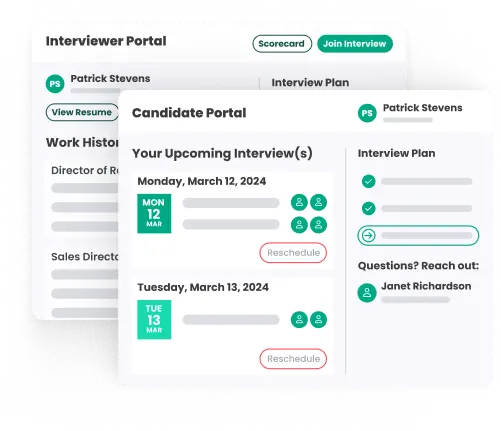Winning top talent in 2025

93%
of companies plan to invest in additional technology to boost hiring efficiency in 2025
93%
of companies plan to invest in additional technology to boost hiring efficiency in 2025
2025’s top challenges
and changes
To succeed in this evolving landscape, talent acquisition teams will need to focus on building stronger candidate relationships (40%) and improving communication throughout the hiring process (39%). Addressing these challenges effectively will require the adoption of innovative solutions like AI, automation, and streamlined processes to balance speed with personalization and secure top talent in a highly competitive market.
AI and automation: The cornerstone of 2025’s hiring strategies
Sector
Top focus area for 2025
Retail
Upgrading hiring technology
Healthcare
Improving overall efficiency
Manufacturing
Improving overall efficiency
Technology
Upgrading hiring technology
Financial Services
Using AI to make hiring more efficient
Talent acquisition team transformation and the evolving role of recruiting coordinators
One role undergoing significant evolution is the recruiting coordinator. Traditionally focused on scheduling and logistics, this position is shifting toward higher-value responsibilities.
To thrive, organizations must invest in upskilling recruiting coordinators to align with the evolving demands of the current talent market. Rather than being phased out, RCs are becoming key drivers of modern talent acquisition strategies, shifting from primarily logistical tasks to balancing technological proficiency with interpersonal expertise. As automation streamlines repetitive tasks, recruiting coordinators will play a critical role in creating personalized and impactful candidate experiences, bridging technology and human connection to deliver competitive results.
"I foresee talent acquisition really uplifting, so they're not going to be recruiters, sourcers, and coordinators, but more of like talent advisors. Everyone's going to be saying, ‘hey, here's how to hire, here's the strategy, here's what we need to do, here's how we do it’ versus ‘Great, hiring manager, I will go find this for you.’"

Megan Hennessy
Former Global Senior Talent Leader | Meta
Improving candidate and interviewer experience
through automation
With speed a shared priority for hiring teams and candidates—and interview cancellations and reschedules cited as a leading bottleneck—automation in scheduling has become indispensable. By automating and streamlining scheduling workflows, organizations can meet candidate expectations for a fast and seamless process—gaining a critical edge in the race for top talent.
"When you’re hiring candidates, speed is critical. Really good candidates often have multiple offers, so we have to be quick. Reducing time-to-schedule ensures we’re able to hire the candidates that we really want and stay competitive."

Bastian Müller
Global Head of Talent Acquisition | OLX

GoodTime’s Candidate Portal and Interviewer Portal help forward-thinking talent teams orchestrate better hiring experiences for everyone.
Learn more
The hiring metrics that
matter most
Looking ahead, the challenge for TA teams will be finding ways to integrate these metrics into actionable insights. With technology and AI continuing to shape the hiring landscape, teams must leverage these tools to measure and optimize their efforts in real-time, ensuring they stay ahead in the race for talent.
"Knowledge is powerful. Do you know how many interviews you schedule in a week or a month, how high your decline rates are, and how that compares to other business lanes in your company?
Knowing these things is the first step to helping your team work more efficiently."

Jennifer Walker
Global Recruiting Coordination Manager | Hubspot
How do you measure quality of hire?
Common ways companies measure quality of hire include:
New hire performance evaluations:
Regular assessments at 90 days, 6 months, and 1 year.
Retention rates:
Tracking the percentage of new hires who remain with the company beyond their first year.
Hiring manager satisfaction scores:
Collecting feedback from hiring managers on new hire effectiveness and readiness.
Candidate experience surveys:
Evaluating the new hire’s perspective on the recruitment process and how well the role matches expectations.
Cultural fit assessments:
Measuring how well new hires align with company values and culture.